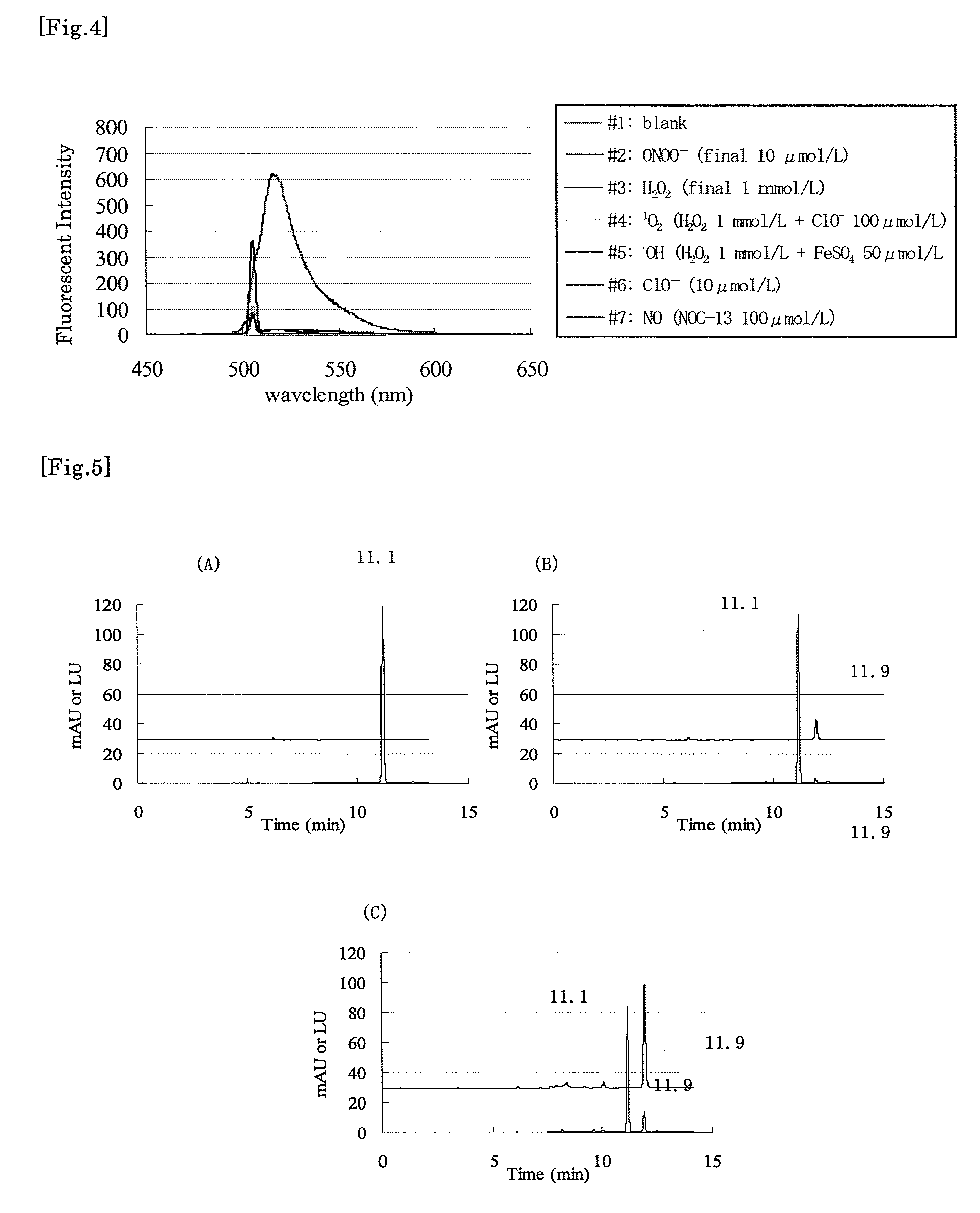Fluorescent probe for peroxynitrite
a peroxynitrite and fluorescent probe technology, applied in chemical methods analysis, instruments, group 3/13 element organic compounds, etc., can solve the problems of inability to detect peroxynitrite in real time, inability to achieve specificity, and inability to reliably detect, etc., to achieve high fluorescent
- Summary
- Abstract
- Description
- Claims
- Application Information
AI Technical Summary
Benefits of technology
Problems solved by technology
Method used
Image
Examples
example 1
Synthesis of Peroxynitrite Fluorescent Probe
[0051]The synthetic scheme of Compound 4 is shown below.
[0052]
(a) Synthesis of 3-cyano-2,4-dimethylpyrrole
[0053]Synthesis was performed according to the method described in known literature (Australian Journal of Chemistry, 17, pp. 1013-1021, 1965).
(b) Synthesis of Compound 1 (4-benzyloxy-2-benzyloxycarbonylmethoxybenzaldehyde)
[0054]4-Benzyloxy-2-hydroxybenzaldehyde (1 g, 4.39 mmol) was dissolved in distilled dimethylformamide (DMF, 8 mL), the solution was added with benzyl bromoacetate (1.1 g, 4.82 mmol) and cesium carbonate (1.57 g, 4.83 mmol), and the mixture was stirred overnight at room temperature under an argon atmosphere. The reaction solution was added with water (150 mL), and the mixture was extracted three times with ethyl acetate (100 mL). The extracted organic layer was washed five times with water (50 mL) and once with saturated brine (100 mL), and dried over anhydrous sodium sulfate. The solvent was evaporated under reduced ...
example 2
Reaction of Compound 4 and Peroxynitrite
[0061]A 10 μmol / L solution of Compound 4 was prepared by diluting a 20 mmol / L solution of Compound 4 in DMF with a 100 mmol / L phosphate buffer (pH 7.4). The solution was added with peroxynitrite solutions of 2 mmol / L, 5 mmol / L, 10 mmol / L, 20 mmol / L and 80 mmol / L at peroxynitrite final concentrations of 1, 2, 4, 5, 10, 20 or 50 μmol / L with stirring, and after 60 seconds, fluorescence spectrum was measured (excitation wavelength: 505 nm). The results are shown in FIGS. 1, 2 and 3. As clearly seen from the results shown in FIGS. 1, 2 and 3, peroxynitrite addition amount-dependent increase in fluorescence intensity was observed (maximum fluorescence wavelength: 518 nm), and therefore it was demonstrated that Compound 4 of the present invention emitted fluorescence by a reaction with peroxynitrite in a peroxynitrite concentration-dependent manner.
example 3
Reaction of Compound 4 and Various Reactive Oxygen Species
[0062]A 10 μmol / L solution of Compound 4 was prepared by diluting a 20 mmol / L solution of Compound 4 in DMF with a 100 mmol / L phosphate buffer (pH 7.4), and used for the test. The prepared solution was treated under the following conditions for 3 minutes (except for (f), for which treatment time was 30 minutes).
(a) Peroxynitrite was added to make a final concentration of 10 μmol / L.
(b) Hydrogen peroxide was added to make a final concentration of 1 mmol / L.
(c) Hydrogen peroxide and hypochlorite ions were added to make final concentrations of 1 mmol / L and 100 μmol / L, respectively.
(d) Hydrogen peroxide and iron(II) sulfate were added to make final concentrations of 1 mmol / L and 50 μmol / L, respectively.
(e) Hypochlorite ions were added to make a final concentration of 10 μmol / L.
(f) NOC-13 (nitrogen monoxide discharging agent, Dojindo Laboratory) was added to make a final concentration of 100 μmol / L.
[0063]After the reaction, change o...
PUM
| Property | Measurement | Unit |
|---|---|---|
| emission wavelength | aaaaa | aaaaa |
| excitation wavelength | aaaaa | aaaaa |
| pH | aaaaa | aaaaa |
Abstract
Description
Claims
Application Information
 Login to View More
Login to View More - R&D
- Intellectual Property
- Life Sciences
- Materials
- Tech Scout
- Unparalleled Data Quality
- Higher Quality Content
- 60% Fewer Hallucinations
Browse by: Latest US Patents, China's latest patents, Technical Efficacy Thesaurus, Application Domain, Technology Topic, Popular Technical Reports.
© 2025 PatSnap. All rights reserved.Legal|Privacy policy|Modern Slavery Act Transparency Statement|Sitemap|About US| Contact US: help@patsnap.com



